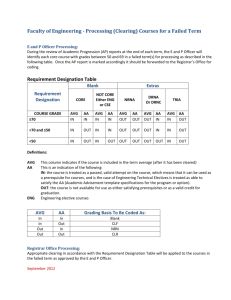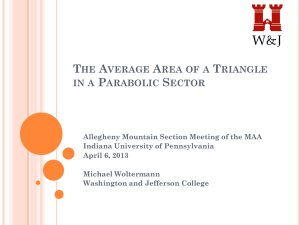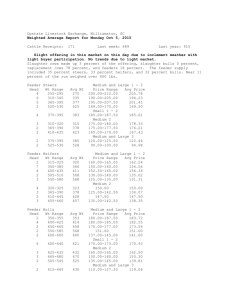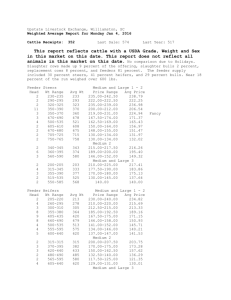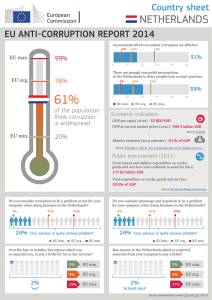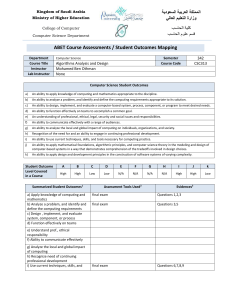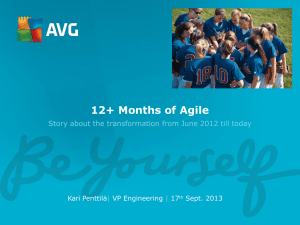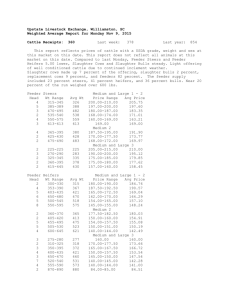Report
advertisement
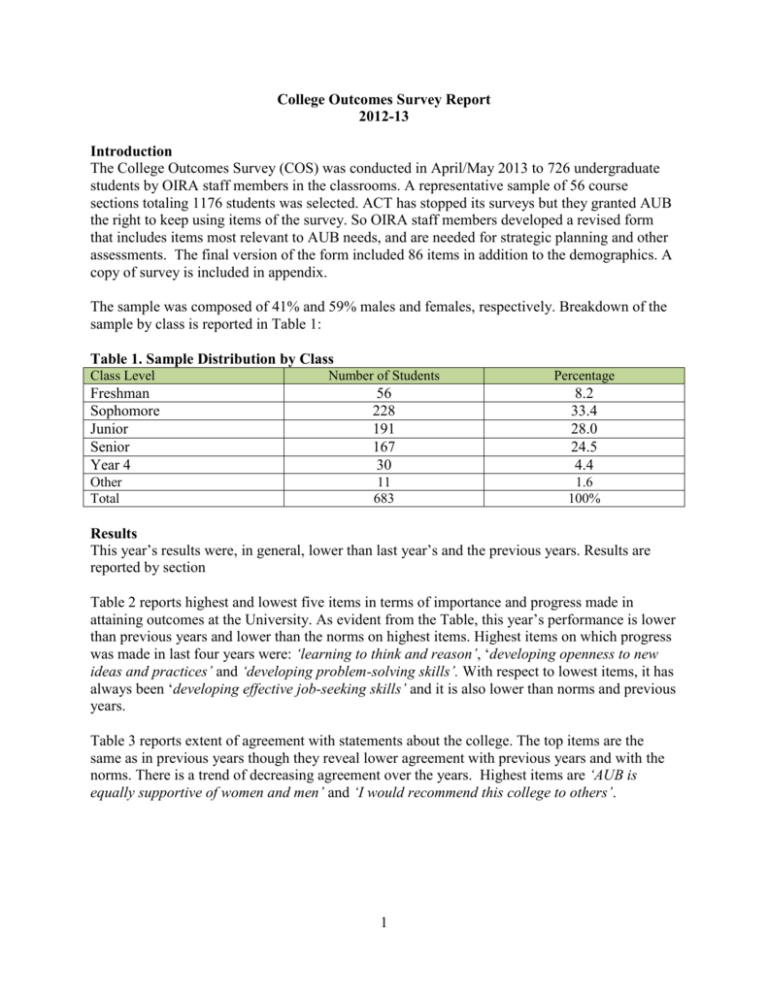
College Outcomes Survey Report 2012-13 Introduction The College Outcomes Survey (COS) was conducted in April/May 2013 to 726 undergraduate students by OIRA staff members in the classrooms. A representative sample of 56 course sections totaling 1176 students was selected. ACT has stopped its surveys but they granted AUB the right to keep using items of the survey. So OIRA staff members developed a revised form that includes items most relevant to AUB needs, and are needed for strategic planning and other assessments. The final version of the form included 86 items in addition to the demographics. A copy of survey is included in appendix. The sample was composed of 41% and 59% males and females, respectively. Breakdown of the sample by class is reported in Table 1: Table 1. Sample Distribution by Class Class Level Number of Students Percentage Freshman Sophomore Junior Senior Year 4 56 228 191 167 30 8.2 33.4 28.0 24.5 4.4 Other Total 11 683 1.6 100% Results This year’s results were, in general, lower than last year’s and the previous years. Results are reported by section Table 2 reports highest and lowest five items in terms of importance and progress made in attaining outcomes at the University. As evident from the Table, this year’s performance is lower than previous years and lower than the norms on highest items. Highest items on which progress was made in last four years were: ‘learning to think and reason’, ‘developing openness to new ideas and practices’ and ‘developing problem-solving skills’. With respect to lowest items, it has always been ‘developing effective job-seeking skills’ and it is also lower than norms and previous years. Table 3 reports extent of agreement with statements about the college. The top items are the same as in previous years though they reveal lower agreement with previous years and with the norms. There is a trend of decreasing agreement over the years. Highest items are ‘AUB is equally supportive of women and men’ and ‘I would recommend this college to others’. 1 Table 2. Progress made in Attaining Outcomes A: PROGRESS TOWARD ATTAINING OUTCOMES AT THIS COLLEGE HIGHEST 5 ITEMS TEXT Learning to think and reason Developing openness to new ideas and practices Locating, screening, and organizing information Thinking objectively about beliefs, attitudes, and values Developing problem-solving skills LOWEST 5 ITEMS TEXT Developing effective job-seeking skills (e.g., interviewing, resume construction) Appreciating the fine arts, music, literature, and the humanities Understanding and applying math concepts and statistical reasoning Learning about the role of science and technology in society Developing my creativity; generating original ideas and products AVG 12-13 3.7 3.7 3.7 3.6 3.6 AVG 11-12 3.9 3.8 AVG 10-11 3.9 3.7 3.7 3.7 AVG 12-13 3.0 AVG 11-12 3.1 AVG 10-11 3.2 3.2 AVG 09-10 3.9 3.8 Norms 10-11 4.0 3.8 3.7 3.8 3.9 AVG 09-10 3.1 Norms 10-11 3.4 3.3 3.4 3.2 3.4 3.3 3.4 3.4 3.7 Table 3. Views of the College ITEM C: AGREEMENT WITH STATEMENTS ABOUT THIS COLLEGE This college is equally supportive of women and men. I would recommend this college to others. If choosing a college I would choose this one. I am proud of my accomplishments at this college. My experiences here have equipped me to deal with possible career changes. This college has helped me meet the goals I came here to achieve. This college welcomes and uses feedback from students to improve the college. AVG 12-13 3.9 3.7 3.6 3.6 3.5 AVG 11-12 4.1 3.9 3.6 3.8 3.6 AVG 10-11 4.2 3.9 3.7 3.8 3.6 AVG 09-10 4.3 4 3.8 3.8 3.7 Norms 10-11 4.1 4.1 3.8 4.3 3.8 3.4 3.6 3.6 3.7 4.1 3.2 3.3 3.5 3.5 3.8 Table 4 reports personal growth and highest three items are nearly the same in the last four years in terms of ‘taking responsibility for own behavior’, ‘interacting well with people from other cultures’, ‘becoming more willing to change and learn new things’, and ‘acquiring a wellrounded general education’. They are also lower than previous years and the norms. 2 With respect to lowest items, the lowest five are still the same as in previous years, though much lower and lower than the norms. AUB needs to work on helping students to ‘recognize their rights, responsibilities, and privileges as citizens’ and to ‘constructively express both emotions and ideas’. Table 4. Personal Growth PERSONAL GROWTH SINCE ENTERING THIS COLLEGE HIGHEST 10 ITEMS TEXT Taking responsibility for my own behavior Interacting well with people from cultures other than my own Becoming more willing to change and learn new things Becoming more willing to consider opposing points of view Acquiring a well-rounded General Education Clarifying my personal values Learning to be adaptable, tolerant, and willing to negotiate Improving my ability to stay with projects until they are finished Becoming academically competent Developing self-confidence LOWEST 10 ITEMS TEXT Recognizing my rights, responsibilities, and privileges as a citizen Learning how to manage finances ( personal, family, or business) Constructively expressing both emotions and ideas Becoming more aware of local and national political and social issues Understanding myself, my talents, and my interests Developing leadership skills Developing moral principles to guide my actions and decisions Becoming an effective team or group member Becoming a more effective member in a multicultural society Preparing to cope with changes as they occur (e.g., in career, relationships, lifestyle) AVG 12-13 3.9 3.8 3.8 3.7 3.7 3.7 3.7 3.7 3.7 3.6 AVG 11-12 4.1 4.1 4 AVG 12-13 3.2 3.3 3.4 3.4 3.5 3.5 3.5 3.5 3.5 AVG 10-11 4.1 4.1 4 4 4.1 Norms 10-11 4.1 3.9 4.0 3.9 4.1 4 3.8 4 4.1 4 AVG 11-12 3.7 3.7 3.7 AVG 10-11 3.7 3.7 AVG 09-10 3.8 3.8 3.8 Norms 10-11 3.7 3.8 3.9 3.6 3.8 3.7 3.7 3.6 4 4 3.9 3.9 3.8 4.1 4 4 AVG 09-10 4.1 4.1 4 4 4.1 4.1 4 3.6 Table 5 reports satisfaction with given aspects of the university, and highest items have been the same in last few years though with lower satisfaction. Security on campus, social activities, college in general, library services, etc has been most recurrent items. With respect to lowest items of satisfaction, quality of academic advising and concern for student as individual have been persistently lowest items. In addition, faculty respect for students and having more informal contact with students were mentioned as items needing improvement. Table 6 reports overall growth and contribution of college to that growth. There has been a drop in growth over all domains but most noticeably in intellectual growth from 4.0 to 3.7. this is alo reported in Figure 1. All areas of growth are lower than the norms though previously were equal or higher than norms (social growth, for example). 3 4 Table 5. Satisfaction with Aspects of University SATISFACTION WITH GIVEN ASPECTS OF THIS COLLEGE HIGHEST 10 ITEMS TEXT Personal security/safety on campus College response to students with special needs ( e.g., disabled, handicapped) Freedom from harassment on campus Language development services for students whose first language is NOT English This college in general College social activities Student health/wellness services Rules governing student conduct Library /learning resources center services Opportunities for involvement in campus activities LOWEST 10 ITEMS TEXT Quality of academic advising Concern for me as an individual Flexible degree requirements Informal contact with faculty in non-academic settings Practical work experiences offered in areas related to my major Career planning services Faculty respect for students Personal counseling services( e.g., resolving personal problems) Variety of courses offered Job placement services (e.g., opportunities to link with employers) AVG 12-13 3.9 AVG 11-12 3.9 AVG 10-11 4 AVG 09-10 4 Norms 10-11 3.8 3.8 3.8 3.8 3.8 3.8 3.8 3.7 3.8 3.8 3.9 3.8 3.7 3.8 3.7 3.9 3.8 3.9 3.9 AVG 11-12 3.1 3 3.2 3.3 AVG 10-11 3.2 3.1 3.3 3.2 AVG 09-10 3.2 3.2 3.2 3.2 3.3 3.4 3.3 3.4 3.5 3.5 3.9 3.8 3.8 3.7 3.7 3.7 3.7 3.6 3.6 AVG 12-13 2.9 2.9 3.0 3.1 3.2 3.3 3.3 3.3 3.3 3.4 3.4 3.6 4.1 3.7 3.6 3.7 4 3.8 Norms 10-11 3.9 3.9 3.8 3.9 3.6 3.7 4.1 3.7 3.8 3.5 Table 6. College Contribution to Growth A: COLLEGE CONTRIBUTION TO GROWTH AND PREPARATION AVG 12-13 Social growth (understanding others and their views, adapting successfully to a variety of social situations) Personal growth (developing self-understanding, self-discipline, and mature attitudes, values, and goals) Intellectual growth (acquiring knowledge, skills, ideas, concepts, analytical thinking) Preparation for further study Preparation for career 4 AVG 11-12 AVG 10-11 AVG 09-10 Norms 10-11 3.7 3.9 3.9 4 3.8 3.7 3.8 3.9 3.9 3.9 3.7 3.5 3.3 4 3.7 3.5 4 3.7 3.6 4 3.8 3.7 4.1 4 3.9 Figure 1. Student Growth 2009-2013 Results by Class level. Appendix reports results by class. It is clear from results that freshmen students have attained higher growth than sophomores as they have higher average scores. Another observation is that the higher the grade levels the higher the scores which reveal a clear developmental growth path for students as they move from entry to higher levels. This is less consistent when agreeing with statements about this college as on some statements there are no differences by class level like ‘I would recommend this college to others’ and on others the higher grades have lower scores like ‘if choosing a college I would choose this one’. Similarly, satisfaction with aspects of college showed higher satisfaction with entering students and this decreases as students reach higher class levels, especially on advising, career services, variety of courses, etc. The same trend applies to personal growth and to college contribution to overall growth with higher levels showing higher scores and higher freshmen scores than sophomores (except on social growth, where sophomores are higher). Overall growth by class is reported in Figure 2. The trend is less consistent for additional items, with some showing an increase with higher grades like ‘I made a class presentation’, ‘I worked with other students on project during classes, and ‘I participated in a community-based project as part of a regular course’, etc. Others remained same like ‘Course syllabi are usually distributed early on in the semester’, and ‘the material covered in class was relevant to stated course objectives’, etc. few went down with higher levels like ‘There was adequate time to cover all of the course topics’ which is logical. Major differences by level are highlighted and colored in appendix. . 5 Figure 2. College Contribution to Growth by Level 4.1 4.0 3.9 3.8 Social growth 3.7 Personal growth 3.6 Intellectual growth 3.5 Preparation for further study 3.4 Preparation for career 3.3 3.2 FRESHMAN SOPHOMORE JUNIOR SENIOR Summary and Conclusion College Outcome Survey was given to a representative sample of nearly 700 students. Results this year revealed a consistency in terms of areas of student growth though with lower averages. Averages dropped on most of the items and reasons for that cannot be identified. Need to see if these results persist or are sporadic related to samp0le who answered survey. Quality of academic advising and career and job related services are still areas where AUB needs to improve. When comparing results by class, freshmen showed highest growth while satisfaction with aspects of university decreased with years at AUB. Similarly, most of the additional items showed a drop in satisfaction with the exception of ‘I made a class presentation’ which significantly improved. COS provides very useful information for measuring AUB success in promoting students growth and development. 6 Appendix: Results by Class Level SUMMARY FOR SECTION II : COL LEGE OUTCOMES A: IMPORT ANC E OF AN D PROGRESS T OWARD AT TAINING OUT COM ES AT THIS COLLEGE PROGRESS AT THIS COLLEGE HIGHEST 5 IT EM S T EXT AVG 12-13 FRESHMAN SOPHOMORE JUNIOR SENIOR GRAD 4.0 3.9 3.8 3.6 3.6 3.7 Learning to think and reas on 2.7 3.8 3.8 3.6 3.6 3.7 Developing openness to new ideas and practices 3.2 3.8 3.7 3.5 3.6 3.7 Loc ating, screening, and organizing information 2.8 3.8 3.7 3.4 3.7 3.6 Thinking objec tively about beliefs , attitudes, and v alues 3.8 3.9 3.6 3.3 3.5 3.6 Developing problem-solving s kills LOWEST 5 ITEMS TEXT Developing effective job-s eeking sk ills (e.g., interviewing, resume construction) Appreciating the fine arts, music, literature, and the hum anities Understanding and applying math c oncepts and statis tical reasoning Learning about the role of s cienc e and technology in society Developing m y creativity; generating original ideas and products AVG 12-13 FRESHMAN SOPHOMORE JUNIOR SENIOR GRAD 2.2 3.3 3.2 2.7 2.6 3.0 1.5 3.3 3.2 3.0 3.4 3.2 2.8 3.3 3.3 3.1 3.2 3.2 2.8 3.4 3.4 3.1 3.2 3.3 2.7 3.6 3.5 3.1 3.4 3.4 SUMMARY FOR SECTION II: COLLEGE OUT COM ES IT EM C: AGREEMENT WITH STAT EMENTS ABOUT THIS COLLEGE This c ollege is equally supportive of women and m en. I would rec om mend this college to others . If choos ing a c ollege I would c hoose this one. I am proud of m y accomplis hm ents at this college. My experiences here have equipped me to deal with pos sible c areer changes . This c ollege has helped me m eet the goals I came here to ac hieve. This c ollege welcomes and uses feedback from students to improv e the college. 7 AVG 12-13 FRESHMAN SOPHOMORE JUNIOR SENIOR UATE 2.8 3.9 3.9 4.0 4.0 3.9 3.3 3.7 3.7 3.7 3.7 3.7 3.5 3.6 3.6 3.7 3.5 3.6 3.3 3.7 3.5 3.5 3.6 3.6 3.8 3.5 3.6 3.4 3.4 3.5 3.3 3.5 3.4 3.3 3.4 3.4 3.3 3.7 3.5 3.5 3.6 3.2 SUMMARY FOR SECTION II : COL LEGE OUTCOMES D: PERSONAL GROWTH AND COLLEGE CONTRIBUTION TOW ARD ATTAIN ING OUTCOMES PERSONAL GROWT H SINCE ENTERING T HIS COLLEGE HIGHEST 10 ITEMS TEXT AVG 12-13 FRESHMAN SOPHOMORE JUNIOR SENIOR GRAD Taking res ponsibility for my own behavior 3.9 3.9 3.9 3.8 3.9 4.0 Interacting well with people from cultures other than my own 3.8 3.8 3.7 3.8 4.0 3.3 Bec om ing more willing to c hange and learn new things 3.8 3.6 3.8 3.7 3.8 3.5 Bec om ing more willing to c onsider oppos ing points of v iew 3.7 3.6 3.6 3.7 3.8 3.2 Acquiring a well-rounded General Educ ation 3.7 3.7 3.6 3.7 3.7 3.4 Clarifying m y personal values 3.7 3.6 3.6 3.6 3.8 3.7 Learning to be adaptable, tolerant, and willing to negotiate 3.7 3.4 3.6 3.7 3.8 3.5 Im proving my ability to stay with projects until they are finished 3.7 3.6 3.5 3.7 3.8 3.2 Bec om ing academically competent 3.7 3.7 3.5 3.6 3.8 3.2 Developing s elf-confidenc e 3.6 3.6 3.6 3.6 3.7 3.8 LOWEST 10 ITEMS TEXT AVG 12-13 FRESHMAN SOPHOMORE JUNIOR SENIOR GRAD Recognizing my rights, respons ibilities , and privileges as a citizen 3.2 3.0 3.1 3.4 3.4 2.7 Learning how to manage finances ( personal, family, or bus iness) 3.3 3.5 3.1 3.4 3.4 3.2 Constructively expres sing both emotions and ideas 3.4 3.6 3.2 3.4 3.5 3.3 Bec om ing more aware of local and national political and social issues 3.4 3.3 3.3 3.5 3.5 3.0 Understanding mys elf, m y talents , and my interes ts 3.5 3.5 3.4 3.5 3.6 3.2 Developing leadership skills 3.5 3.4 3.2 3.6 3.8 3.0 Developing m oral principles to guide m y actions and decisions 3.5 3.6 3.4 3.5 3.7 2.7 Bec om ing an effectiv e team or group member 3.5 3.1 3.3 3.7 3.6 3.3 Bec om ing a more effective member in a m ultic ultural society 3.5 3.5 3.3 3.6 3.7 3.0 Preparing to c ope with changes as they oc cur (e.g., in c areer, relationships, lifestyle) 3.6 3.5 3.4 3.6 3.7 3.7 8 SUMMARY FOR SECTION III : COLLEGE OUTCOMES SAT ISFACTION W ITH GIVEN ASPECTS OF T HIS COLLEGE HIGHEST 10 ITEMS TEXT Personal security/safety on cam pus Colle ge response to students with special needs ( e.g., disabled, handic apped) Freedom from harassm ent on cam pus Language development servic es for students whose first language is NOT English This college in general Colle ge social activities Student health/wellness services Rules governing student conduct Library /learning resources center services Opportunities for involvement in campus activ it ies LOWEST 10 ITEMS TEXT AVG 12-13 FRESHMAN SOPHOMORE JUNIOR SENIOR GRAD 3.9 4.1 4.0 3.9 3.8 3.2 3.9 3.9 4.0 3.8 3.7 2.2 3.8 4.1 3.8 3.8 3.7 4.0 3.8 4.0 3.8 3.7 3.7 3.6 3.7 3.8 3.8 3.6 3.7 3.3 3.7 3.7 3.8 3.7 3.5 2.8 3.7 4.0 3.8 3.6 3.5 3.6 3.7 3.9 3.8 3.6 3.6 3.0 3.6 3.6 3.8 3.6 3.5 2.5 3.6 3.4 3.7 3.6 3.7 2.0 AVG 12-13 FRESHMAN SOPHOMORE JUNIOR SENIOR GRAD 2.9 2.8 3.0 2.9 2.8 2.8 2.9 3.0 3.0 2.9 2.9 2.2 3.0 3.0 3.2 2.9 2.9 3.0 3.1 3.1 3.1 3.2 2.9 2.8 3.2 3.6 3.4 3.2 3.0 2.0 3.3 3.5 3.4 3.3 3.2 1.3 3.3 3.6 3.5 3.2 3.1 2.6 3.3 3.7 3.4 3.2 3.2 2.8 3.3 3.3 3.6 3.2 3.1 2.3 3.4 3.6 3.6 3.3 3.2 2.0 Quality of academic advising Concern for me as an individual Flexible degree requirements Informal contact with faculty in non-academ ic settin gs Practical work experiences offered in areas related to my major Career planning services Faculty respect for students Personal counseling services( e.g., resolving personal problem s) Variety of courses offered Job placement services (e.g., opportunities to link with em ployers) SUMMARY FOR SECTION IV : YOUR EXPERIENCES AT T HIS COLLEGE A: COLLEGE CONT RIBUT ION TO GROWTH AND PR EPARATION AVG 12-13 FRESHMAN SOPHOMORE JUNIOR SENIOR GRAD Socia l growth (understanding others and their views, adapting successfully to a variety of3.7 socia l sit uations) 3.6 3.7 3.7 3.8 3.8 Personal growth (developin g self-understanding, self-discipline, and mature attitudes, values, 3.7 and goals)3.6 3.6 3.7 3.7 3.5 Intellectual growth (acquiring knowledge, skills, ideas, concepts, analytical thinking) 3.7 3.7 3.6 3.7 3.7 2.8 Preparation for further study 3.5 3.7 3.5 3.6 3.5 2.3 Preparation for career 3.3 3.4 3.3 3.3 3.5 2.5 9 SECTION V: ADDITIONAL QUESTIONS Avg 12-13 FRESHMAN SOPHOMORE JUNIOR SENIOR GRAD 1.The objectiv es of the courses that I have taken were clearly stated. 2.Course syllabi are usually distributed early on in the semester. 3.The syllabi usually inclu ded course outcomes i.e. the skills that the students ought to acquire by the end of the course. 4.The material covered in class was relevant to stated course objectives 5.There was adequate time to cover all of the course topics. 6. I often encouraged in problem - solving in cla ss. 7.Teachers usually invited students to relate outside events/activities to subjects covered in the courses. 8.Teachers clearly explained their grading policy to students at the begin ning of courses. 9.Teachers usually evaluated student performance periodically. 10.Teachers usually discussed performance and progress wit h students. 11. I received prompt feedback from faculty on m y academic performance (written or oral) 12. I asked questions in class or contrib uted to class dis cussions 13. I made a class presentation 14. I worked with other students on project during class 15. I worked with classmates outside class to prepare class assignments 16. I participated in a community-based project as part of a regular course 17.I was motivated to do as well as I could in my classes. 18. I worked harder than I thought to m eet the instructor's standards and expectatio ns 19. Campus environment emphasized time studying and academic work. 20.I have heard faculty refer to their research. 21.I have talked with faculty members about my career plans. 22.I have worked wit h a faculty m em ber on research projects. 23. I am satisfied with the servic es offered by the Writing Center. 24.AUB experie nces helped me develop as a self learner. 10 3.6 4.1 4.0 3.8 3.4 3.4 3.3 3.6 3.3 3.1 2.9 3.7 4.0 3.9 3.8 3.1 3.5 3.6 3.6 3.4 2.9 2.7 3.3 3.8 3.5 4.1 3.9 3.8 3.6 3.4 3.4 3.7 3.5 3.3 2.8 3.6 4.1 3.8 3.7 2.8 3.5 3.5 3.7 3.1 2.9 2.5 3.1 3.7 3.6 4.2 4.0 3.9 3.5 3.4 3.1 3.5 3.1 2.9 2.7 3.6 3.9 3.8 3.6 3.0 3.6 3.6 3.5 3.2 2.7 2.5 3.2 3.7 3.7 4.0 4.0 3.8 3.3 3.4 3.3 3.7 3.3 3.1 3.1 3.7 3.9 3.8 3.7 3.2 3.4 3.7 3.5 3.4 3.0 2.8 3.3 3.8 3.7 4.1 4.0 3.8 3.4 3.5 3.3 3.6 3.4 3.2 3.0 3.7 4.1 4.0 4.0 3.3 3.7 3.6 3.6 3.6 3.2 2.7 3.3 3.8 2.5 3.5 3.0 2.5 2.8 1.8 3.3 3.3 2.0 2.5 3.3 4.0 4.3 4.3 4.0 2.3 2.3 4.0 3.0 3.0 1.7 1.7 1.7 3.0 Additional Items Comparison College Outcomes Survey Additional Questions Comparison Report 11-12 & 12-13 SECTION V: ADDITIONAL QUESTIONS Avg 12-13 Avg 11-12 2.Course syllabi are usually distributed early on in the semester. 4.1 3.The syllabi usually included course outcomes i.e. the skills that the students ought to acquire by the end of the course. 4.0 13. I made a class presentation 4.0 14. I worked with other students on project during class 3.9 4.The material covered in class was relevant to stated course objectives 3.8 24.AUB experiences helped me develop as a self learner. 3.8 15. I worked with classmates outside class to prepare class assignments 3.8 12. I asked questions in class or contributed to class discussions 3.7 1.The objectives of the courses that I have taken were clearly stated. 3.6 18. I worked harder than I thought to meet the instructor's standards and expectations 3.6 8.Teachers clearly explained their grading policy to students at the beginning of courses. 3.6 19. Campus environment emphasized time studying and academic work. 3.6 17.I was motivated to do as well as I could in my classes. 3.5 5.There was adequate time to cover all of the course topics. 3.4 6. I often encouraged in problem- solving in class. 3.4 20.I have heard faculty refer to their research. 3.4 9.Teachers usually evaluated student performance periodically. 3.3 23. I am satisfied with the services offered by the Writing Center. 3.3 7.Teachers usually invited students to relate outside events/activities to subjects covered in the courses. 3.3 16. I participated in a community-based project as part of a regular course 3.1 10.Teachers usually discussed performance and progress with students. 3.1 21.I have talked with faculty members about my career plans. 2.9 11. I received prompt feedback from faculty on my academic performance (written or oral) 2.9 22.I have worked with a faculty member on research projects. 2.7 11 4.4 4.1 3.7 3.8 4.1 4.0 3.8 3.7 4.1 3.9 3.6 3.7 3.8 3.7 3.5 3.4 3.5 3.4 3.5 3.1 3.3 3.2 3.2 3.0 Dif. -0.3 -0.1 0.3 0.1 -0.3 -0.2 0.0 0.0 -0.4 -0.3 -0.1 -0.1 -0.3 -0.3 -0.1 0.0 -0.2 -0.1 -0.2 0.0 -0.2 -0.3 -0.3 -0.3
